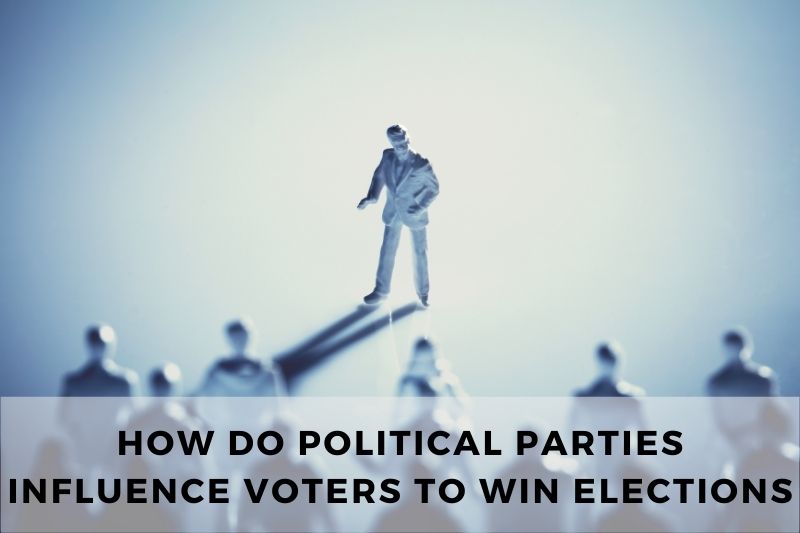
Winning elections is the ultimate goal for political parties operating in a democracy. But how do they do it? Winning elections involves a sophisticated mix of strategies and tactics aimed at influencing voters, getting them to polling stations and making them cast their vote for your candidate. From advertising campaigns to emotional appeals, promises, and media manipulation, political parties leave no stone unturned in their quest for victory.
In this article, we delve into the different ways political parties influence voters to secure electoral success. Understanding these mechanisms is essential for deciphering the dynamics of modern democratic systems. Let’s explore the strategies that shape political landscapes and determine election outcomes.
How Do Political Parties Influence Voters to Win Elections
#1. Advertising and Marketing Campaigns
Advertising and marketing campaigns play a pivotal role in shaping public perception and swaying voter sentiment. Political parties invest significant resources in crafting persuasive messages tailored to appeal to target demographics. Utilizing various political advertising techniques mediums such as television, radio, print, and digital platforms, they inundate the public with their messaging. Catchy slogans, memorable jingles, and compelling visuals are employed to leave a lasting impression on voters’ minds.
#2. Emotional Appeals
Appealing to emotions is a time-tested strategy employed by political parties to connect with voters on a personal level. Whether evoking feelings of hope, fear, anger, or nostalgia, emotive appeals can influence decision-making processes. By tapping into deeply held beliefs and aspirations, parties seek to foster a sense of identification and loyalty among voters. Emotional resonance often transcends rational arguments, making it a potent tool in the political arsenal.
#3. Promises and Manifesto
Promises and manifesto pledges serve as a roadmap for political parties to outline their policy agendas and vision for the future. Parties craft meticulously curated platforms aimed at addressing key issues and concerns facing the electorate. By offering concrete solutions and policy proposals, they seek to garner support and win over undecided voters. However, the credibility and feasibility of these promises are scrutinized by both opponents and voters alike.
#4. Mobilization Efforts
Mobilization efforts are crucial for ensuring voter turnout and galvanizing support on election day. Political parties deploy extensive ground operations to rally supporters, canvass neighborhoods, and drive voter participation. Door-to-door campaigning, phone banking, and targeted outreach activities are common tactics used to mobilize supporters and sway undecided voters. Effective mobilization can make the difference between victory and defeat in closely contested elections.
#5. Media Manipulation
In an era dominated by mass media, controlling the narrative is paramount for political parties vying for electoral success. Parties leverage their influence over mainstream media outlets to shape public discourse and frame issues in a favorable light. Through strategic media placements, press releases, and press conferences, they attempt to control the flow of information and manage perceptions. However, the rise of social media has introduced new challenges and opportunities for parties to disseminate their messaging effectively.
#6. Targeting Specific Voter Groups
Political parties employ targeted strategies to appeal to specific voter demographics based on factors such as age, gender, ethnicity, and socioeconomic status. By tailoring their messaging and policy proposals to resonate with the concerns and priorities of different groups, parties seek to maximize their electoral support. Micro-targeting techniques utilizing voter data and analytics enable parties to refine their outreach efforts and tailor their communication strategies accordingly.
#7. Issue-Based Campaigning
Issue-based campaigning revolves around highlighting specific policy issues and contrasting the party’s stance with that of opponents. Parties strategically emphasize their positions on key issues such as healthcare, education, the economy, and national security to differentiate themselves and attract voters. By framing the debate around these salient issues, parties aim to rally support from voters who prioritize particular policy areas in their decision-making process.
#8. Grassroots Organizing
Grassroots organizing entails building support from the bottom up by mobilizing volunteers, activists, and community organizations. Political parties engage in grassroots efforts to establish a strong presence at the local level, foster connections with voters, and cultivate grassroots leadership. Door-knocking campaigns, town hall meetings, and grassroots fundraisers are among the tactics employed to cultivate support and build momentum leading up to elections.
#9. Personalities and Leadership
The persona and leadership qualities of political candidates play a significant role in shaping voter perceptions and electoral outcomes. Parties carefully select candidates who embody charisma, authenticity, and relatability to resonate with voters. Strong leadership qualities, effective communication skills, and a compelling personal narrative can enhance a candidate’s appeal and sway undecided voters. Conversely, flaws or controversies surrounding a candidate can undermine the party’s electoral prospects.
#10. Negative Campaigning
Negative campaigning involves attacking opponents’ character, credibility, or policy positions to diminish their electoral prospects. While often criticized for fostering cynicism and polarization, negative campaigning can be an effective strategy for discrediting opponents and mobilizing the party base. Attack ads, smear campaigns, and mudslinging tactics are deployed strategically to undermine opponents’ credibility and sway undecided voters. However, excessive negativity can backfire and alienate voters, necessitating a careful balance in messaging and tone.
Closing Thoughts
In the cutthroat world of politics, winning elections requires a multifaceted approach that combines strategic messaging, mobilization efforts, and targeted outreach. Political parties employ a diverse array of tactics, from advertising campaigns to grassroots organizing, to influence voter behavior and secure electoral success. Understanding these mechanisms is essential for navigating the complexities of modern democracy. As voters, being aware of the strategies employed by political parties allows us to critically evaluate their messaging and make informed decisions at the ballot box. Ultimately, the dynamics of elections underscore the importance of active citizen engagement and participation in shaping the future of our societies.
